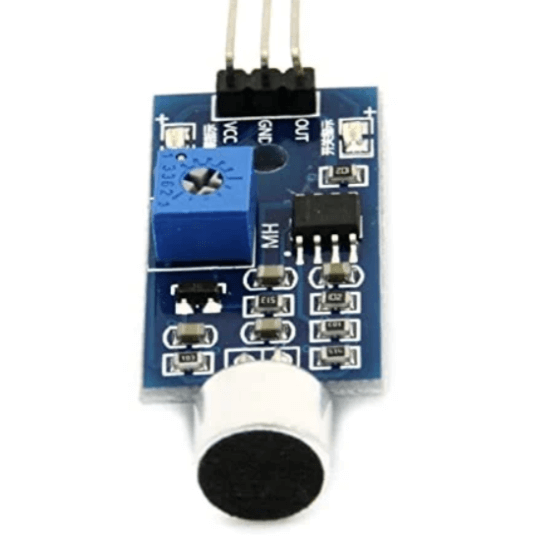Sound Detection Sensor Module
In stock
- Product: Sound Detection Sensor Module
- Operating voltage 3.3V-5V
- Signal output indication
- Single channel signal output
- Light weight
₹60.00 ₹149.00 (Price Excl. GST) ₹50.85
In stock
CompareA sound sensor is defined as a module that detects sound waves through their intensity and converts them to electrical signals. The sound detection sensor module for Arduino detects whether the sound has exceeded a threshold value. Sound is detected via microphone and fed into an LM393 op-amp. The sound level set point is adjusted via an onboard potentiometer. When the sound level exceeds the set point, an LED on the module is illuminated and the output is sent low.
A sound detection sensor module is a compact electronic device designed to detect sound waves and convert them into electrical signals for further processing or triggering specific actions. These modules are commonly utilized in various applications, ranging from security systems to automated industrial processes and smart home devices. The functionality of a sound detection sensor module relies on its internal components and the principles of sound wave detection.
At the heart of a sound detection sensor module is a microphone, which serves as the primary sensor element. The microphone captures sound waves from the surrounding environment and converts them into corresponding electrical signals. These signals are then amplified and processed by the module’s circuitry to detect specific characteristics or patterns indicative of sound presence.
One of the key features of sound detection sensor modules is their sensitivity adjustment capability. This allows users to fine-tune the module’s sensitivity to different sound levels, enabling it to detect sounds within a specific range or threshold. By adjusting the sensitivity, users can customize the module’s response to match the requirements of their application, whether it involves detecting faint whispers or loud noises.
Sound detection sensor modules often incorporate additional circuitry to filter out background noise and enhance the accuracy of sound detection. This may include components such as bandpass filters, which selectively pass frequencies within the range of interest while attenuating others. By filtering out unwanted noise, the module can focus on detecting relevant sound signals more effectively.
Upon detecting a sound signal that exceeds the configured threshold, the sensor module typically triggers an output signal or performs a predefined action. This output signal can be used to activate alarms, initiate recording devices, or control other electronic components in the system. For example, in a security system, the detection of a suspicious sound could trigger an alarm to alert the occupants or notify authorities.
Sound detection sensor modules are often designed to be compact, low-power, and easy to integrate into various electronic systems. They may feature standardized interfaces such as digital or analog outputs, making them compatible with a wide range of microcontrollers, single-board computers, and other electronic devices. This versatility allows developers to incorporate sound detection capabilities into their projects without extensive hardware modifications.
In addition to basic sound detection functionality, some advanced sensor modules offer additional features such as frequency analysis, sound classification, or directional sensing. These features enable more sophisticated applications, such as identifying specific types of sounds or determining the direction from which the sound originates.
Overall, sound detection sensor modules play a crucial role in numerous applications where the monitoring and analysis of sound signals are essential. From security and surveillance to industrial automation and smart environments, these compact devices provide reliable and customizable solutions for detecting and responding to sound events in real time. With ongoing advancements in sensor technology, sound detection modules continue to evolve, offering improved performance, enhanced features, and broader applicability across diverse industries and use cases.
Features:
- Operating voltage 3.3V-5V
- Outputs digital switching output (high and low levels 0 and 1
- Operating current (Vcc=5V): 4-8mA
- Microphone sensitivity (1Khz): 52-48dB
- Microphone Impedance: 2.2KΩ
- Microphone Frequency: 16-20Khz
- Microphone S/N ratio: 54dB
- Signal output indication
- Single-channel signal output
- Outputs low level and the signal light when there is sound
Package Includes:
1 x Sound Detection Sensor Module
Specifications
| Operating voltage | 3.3V-5V |
|---|---|
| Digital switching output (high and low levels) | 0 and 1 |
| Operating current (Vcc=5V) | 4-8mA |
| Microphone sensitivity (1Khz) | 52-48dB |
| Microphone Impedance | 2.2KΩ |
| Microphone Frequency | 16-20Khz |
| Microphone S/N ratio | 54dB |
| Shipping Weight | 0.003 kg |
| Shipping Dimensions | 4 × 3 × 2 cm |
Shipping & Returns
Due to the type of products we sell, we accept limited returns. Below are the conditions where we can accept a return request.
MANUFACTURING DEFECT
If you receive a product with a manufacturing defect, please notify us within 1 day of receiving the product, supported by the proper pictures and description. Once our support team accept the return, we will provide a replacement or a complete refund including the return shipping cost.
WRONG ITEM SHIPPED
If you receive a different product than the ordered one, please contact us within 1 day of receiving the product, supported by the proper pictures and description. Once our support team accept the return, we will provide a replacement or a complete refund including the return shipping cost.
LIMITATION OF RETURNS
We don’t accept returns for products damaged by improper use of the product. Moreover, we don’t accept the return if the ordered product is unsuitable for any specific application. Please read the product specifications and datasheet before selecting and ordering a product.
WHAT VOID WARRANTY?
If the product is subject to misuse, tampering, static discharge, accident, water or fire damage, use of chemicals & soldered or altered in any way.
SHIPPING
We ship all over India. Please contact our support team at info@inventkart.com for any questions related to shipping.
Based on 0 reviews
Be the first to review “Sound Detection Sensor Module”
You must be logged in to post a review.









There are no reviews yet.